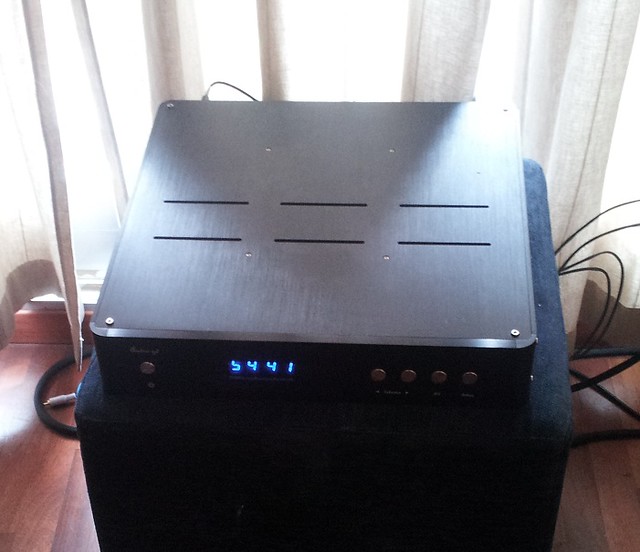This review describes extensively the sound of Audio-gd NFB-9.2. The DAC is aimed to sound very linear. It uses dual Wolfson WM8741 dac chips, has several inputs (including usb with its newer Tenor TE8802 chip, whose upgrade marks the model change from the former 9.1), and offers both single ended and balanced output.
The dac comes with a remote for digital volume control. It works well, with no apparent sq degradation for slight volume changes, although as a rule I prefer to regulate volume through the amplifier.
For this test, I have been using the following gear:
Headphones:
AKG K501, Yuin PK1, Apuresound Etymotic ER4P/S, Etymotic HF5 (with and without PtoS adapter), Audio-Technica AD2000
Amplification:
Burson HA-160DS amp section, Eximus DP-1 amp section
Interconnects:
VH Audio Silver DIY recipe, Moray James 2011 design, some random Fudao cables
Sonic thoughts:
The general character of the DAC is spacious, powerful, weighty; offers big images through headphone listening. It’s transparent, there is a bit of edge in the highest frequencies. The detail reproduction is very high. The bass is pretty tight, there is sense of power. Images in the midrange are big, although not as focused as with the Eximus DP-1.
As I was using the Burson HA-160DS as amplifier, I will do a dirty comparison with its cheaper dac section (200-300$ range). I have described the DAC in the Burson as a bit empty sounding, due to lack of midrange personality. Switching to the NFB-9.2 provides improvements in every area: the sound gets much more spacious, detailed, powerful. Using Burson HA-160 DAC/amp alone makes the listener feel like the DAC is the weakest part in the chain. Switching to an Audio-gd NFB-9.2 -> HA-160 (amp only), the “values” are switched, and the NFB-9.2 takes the part of the “star” in the system.
With some upper treble energy excess, the Audio-gd DAC makes the detail rendition a bit stickier.
I have had some fun trying two different systems against each other: the Eximus DP-1 dac/amp combo alone, versus the Audio-gd 9.2 + Burson HA-160 amp. The first one costs around 3000$, the second combo (with VH Audio cables) would be around 2400$.
While the level of resolution is in a similar scale, the Eximus had tighter bass (with much better definition) and treble refinement. Also the sense of coherence in the music was better.
The sense of blurriness in the bass, though, is given by the Burson amplifier. Ruling it out, and using the NFB-9.2 through Eximus amplifier, the difference in bass reproduction becomes much smaller, with close degree of definition and precision. The Audio-gd flavour comes out as flatter and more transparent than using Burson amplifier, with (comparatively to the Eximus) more energy in the upper register.
If I had to trace the main differences between the Eximus DP-1 DAC section and the Audio-gd, through the Eximus DP-1 amp section, I would say that the Eximus has more saturated midrange (only excessive if coupled with Audio-Technica AD2000), and smoother treble. The Audio-gd offers slightly more powerful bass, less midrange personality, and treble that can get sticky.

Matching suggestions:
Among the headphones I could test, I especially liked AKG K501 with the Audio-gd. Apuresound ER4P were also a good pairing. With ER4S (and HF5 with PtoS adapter) there was a bit too much crispiness in the upper treble region and microdetail retrieval.
The Audio-gd is very pleasing with headphones having good midrange reproduction, being them correct reproducing ones (AKG K501, or Sennheiser HD600… or Stax SR-X Mk3 Pro and SR-003, for that matter), or forward sounding ones (my bias: Etymotic variants, Grado’s), and I’d be also curious to use it with HD650, which sounded great with Eximus when I could try the combo in a shop.
I feel that, out of all my three sources (NFB-9.2, Eximus DP-1, Halide DAC HD), the NFB-9.2 is probably the best match for my Audio Technica AD2000: The AD2000 has very prominent midrange, often crossing the border of being peaky in the upper midrange / lower treble. Such exaggerated frequency response also makes the bass sound leaner than it actually is. The pairing takes the advantage offered by the Audio-gd DAC’s bass weight, expansive sound and flat midrange, which basically enhances all the sonic characteristics of the AD2000. I would strongly advise towards this combo, especially for Audio Technica lovers.
As far as amps go, I’d use either a very smooth and transparent solid-state amplifier (being it, as an example, the amp section in Eximus DP-1), or neutral tube amplifier. The Burson amp gives some justice to the NFB-9.2 DAC already, but the dac can still scale.
Other thougths (mostly USB related):
Using it through USB, I have noticed that, at times, my computer needs to be rebooted, otherwise Foobar2000 would start producing glitches when reproducing the music. The same doesn’t occur when using other digital inputs. I have noticed, that artifacts happened more when my Laptop was “resurrected” from Hibernation state (basically, when Windows 7 freezes the session and the computer switches off).
I will have to try other USB cables at some point, and I am going to install the drivers (which can be found on Audio-gd website) on other USB ports as well.
I wish I had a Stello U3 at hand, to see how the Tenor Chip fares against high quality external converters. I’d be expecting much also from Art Veloce (as soon as it comes out), or the future 192 kHz version of Halide Bridge to provide a better input to the DAC.
Tony


